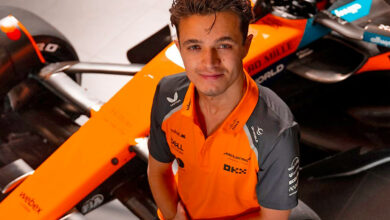F1 Brazilian GP: Who Was At Fault Among Piastri, Antonelli, and Leclerc? An Analysis of the Incident
The incident during the Brazilian GP restart involving Piastri, Antonelli, and Leclerc sparked strong controversy. Who is truly responsible for the contact that ended the Monegasque's race? We analyze the dynamic and why the FIA penalized the Australian driver.

The 2025 Brazilian Grand Prix delivered strong emotions, but also controversy. Among these, the incident involving Kimi Antonelli, Oscar Piastri, and an unfortunate Charles Leclerc on lap six, in Turn 1, immediately after the Safety Car restart, stands out. A contact that triggered a chain reaction: the Italian driver for Mercedes hit Charles Leclerc‘s Ferrari, whose race ended after just a few kilometres.
The Dynamic of the Incident Between Piastri, Antonelli, and Leclerc: a Complicated Restart
At the green flag, Antonelli, second on the grid, did not have the best start. An excess of aggression on the throttle caused his rear wheels to slip, slowing his launch. Leclerc took advantage on the outside, while Piastri attempted a move on the inside. Three drivers in a few metres, three trajectories destined to converge at the same point.
However, the Australian’s McLaren arrived from further back and, despite braking earlier than the other two, could not slow down sufficiently to complete the manoeuvre. Piastri locked the front right, partially lost control, and hit the rear left of the Mercedes, which then ricocheted into the Ferrari. Leclerc was the most unfortunate: destroyed suspension and immediate retirement, while Antonelli managed to continue, albeit with a damaged car, eventually securing a valuable second place finish.
The Stewards’ Decision: Full Blame for Piastri
Race Control took little time to rule: a 10-second penalty for Oscar Piastri. A sanction based on a very specific regulatory point. The FIA guidelines establish that, to have the right of way, a car must be alongside at least up to the mirrors of the car ahead. In this case, the McLaren had not reached that degree of overlap before the apex, and thus the penalty seemed inevitable.
The official document from the stewards clearly shows that the lack of full alongside positioning was the decisive factor: Piastri was only with his front axle aligned with the middle of the Mercedes car, a position which, according to the rules, did not give him the right to force the corner.
Despite the regulatory clarity, the incident remains a subject of debate. On one hand, there is the formal correctness of the decision: Piastri was not alongside enough and lost control. On the other hand, there is the human interpretation of the manoeuvre: Antonelli, not seeing the McLaren, closed the line, thinking the Australian had already slowed down.
In reality, Antonelli’s words, “I couldn’t see him anymore, I thought he had braked earlier,” perfectly explain the origin of the misunderstanding. The young Italian did not deliberately close the door, but simply acted based on incorrect visual information.
The Technical Context: Why Piastri’s Penalty Makes Sense
The regulation is written precisely to avoid situations like this: partial entries on the inside that often generate spins or avoidable incidents. It is the same principle applied in the past in cases like Hamilton–Albon at Interlagos 2021 or more recently Lawson–Bearman in the Sprint.
The risk is always the same: those attempting the attack from too far back end up hitting the driver who is setting up for the corner, often without consequences for themselves but with serious damage to the other. From this perspective, the penalty for Piastri appears not only regulatory but also functional to safety and the consistency of sporting decisions.
In the end, Antonelli can still smile: the second place in Interlagos is a breath of fresh air after difficult weeks and confirms his progress in the second half of the season. For Piastri, however, the episode represents a tough setback in the championship race, with a penalty that weighs both on morale and on the standings.
A tough contact, certainly, but also a reminder of how thin the line is between audacity and imprudence, especially in a Turn 1 like Interlagos, which is unforgiving.




